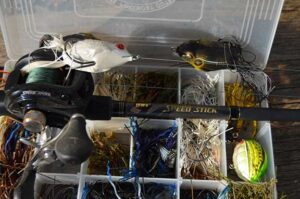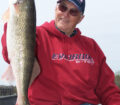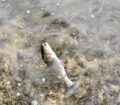By Bob Jensen
Fishing the Midwest Fishing Team

(photo by Bob Jensen) A fake frog and a heavy duty rod, reel, and line will take largemouth bass from the heaviest cover.
It’s been several years since I started using artificial frogs for largemouth bass. Before that, friends and I had used live frogs as catfish bait and I never liked it that much. I didn’t enjoy putting a live frog on a hook and offering it to a hungry catfish. At some point, no matter how effective the frogs were for catfish, I decided “no more”. I’ll find another way to catch’em.
One day while fishing with bass expert Mike Frisch, he suggested that we throw frogs around for largemouth bass. After he explained that these were fake frogs, I agreed to participate. I’m glad I did. And while I still won’t use live frogs for fishing, I’ll gladly cast plastic frogs into bassy looking places.
Using artificial frogs for largemouth bass is very visual. You’ll see every strike: Sometimes the bass will lightly slurp the frog off the surface, other times they’ll smash it.
Often a wake in the water will reveal the approach of a hungry bass. Other times you’ll see the lily-pads or reeds moving as the bass approaches. It’s one of the most exciting ways to catch largemouth bass.
This is mostly a shallow water pattern. Approach the area to be fished quietly. If you make too much noise, you’ll often see the water boil as the bass spook out of the area. Moving into the shallows with the outboard running will spook them as will dropping equipment on the floor of the boat.
Quick motions can spook fish. Some shallow water experts suggest wearing clothing colors that blend in with the sky. The sky is the background to what the fish see, and light colored clothing blends in with the sky better than dark clothing.
Now that you’re in the area to be fished, you need a bait. You want something that will come through the heavy cover without getting hung up. A KVD Poppin’ Perch, Sexy Frog, or a Hack Attack Pad Perch will do that. They all have a different action in the water, and sometimes a particular action will be more appealing to the bass.
For instance, the Poppin’ Perch creates more noise than the Frog. Everyone in the boat should be throwing something different until the fish reveal their preference.
Fish quickly and cover water. Cast to the edges of the vegetation, and also cast beyond the heaviest clumps and retrieve your bait so it goes right through the middle of those heavy clumps. Try a straight retrieve, but also experiment with a stop and go retrieve. A strike will often occur as the bait starts moving after a pause.
One of the keys is to try not to get too excited when a fish hits, and this can be hard to do. When you see the strike, drop the tip of your rod to the fish, then set the hook hard.
This is heavy cover fishing, so you need equipment designed for heavy cover. Fifty pound test line is a good starting point. There are rods made just for froggin’, but I like a Lew’s Flippin’ rod due to its versatility. It does a good job with frogs, but also is outstanding for pitching jigs and casting spinnerbaits.
If this visual action sounds like something that you would enjoy, it’s going on now and will throughout the rest of the summer and into the fall. Get some artificial frogs, leave the real ones alone, and find out how much fun and productive this shallow water bass action can be.
















